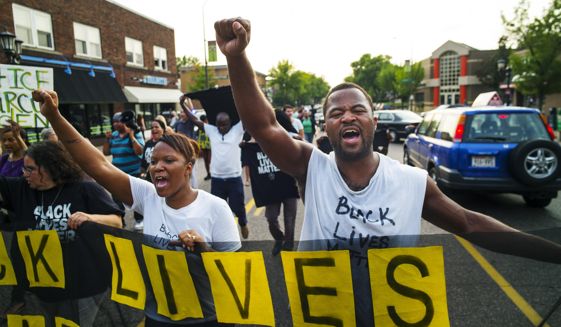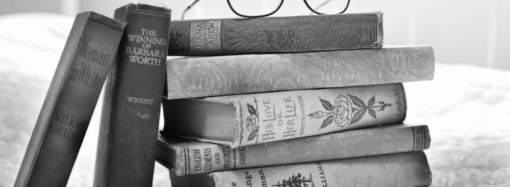Oddly enough in our hyper-cynical society, there seems to be little questioning about underlying goals of some of the #BlackLivesMatter protests and related on-campus activism.
Not to worry, Tom Wolfe did the job, pulling back the curtain for us way back in 1970. That’s probably a good thing since there probably aren’t any authors who are as brave today or as talented.
In Mau-Mauing the Flak Catchers, Tom Wolfe, author of The Right Stuff and The Bonfire of the Vanities, describes the changes that took place in American black culture with the rise of federal and local bureaucratic programs in the 1960s aimed at curing poverty and creating equity. From Wolfe’s perspective, there was a large pot of money that was there for the taking and in all his un-PC ways, he describes how things went down and uses the term “mau-mauing” to describe the activity of threatening the bureaucrats and white leadership in order to secure patronage.
“Ninety-nine percent of the time whites were in no physical danger whatsoever during mau-mauing. The brothers understood through and through that it was a tactic, a procedure, a game. If you actually hurt or endangered somebody at one of these sessions, you were only cutting yourself off from whatever was being handed out, the jobs, the money, the influence. The idea was to terrify but don’t touch. The term mau-mauing itself expressed this game-like quality. It expressed the put-on side of it. In public you used the same term the whites used, namely, “confrontation.” The term mau-mauing was a source of amusement in private. The term mau-mauing said, ‘The white man has a voodoo fear of us, because deep down he still thinks we’re savages. Right? So we’re going to do that Savage number for him.’ It was like a practical joke at the expense of the white man’s superstitiousness.”
Wolfe describes how the practice spread:
“Sometimes a group of buddies who ran together, who were ‘stone pimp,’ as the phrase went, would move straight into the poverty program. They would do some fabulous, awesome, inspired mau-mauing, and the first thing you knew, they would be hanging out in the poverty scene. The middle-class bureaucrats, black and white, would never know what to make of an organization like this. They couldn’t figure them out.”
Some of the examples and consequences Wolfe cites should cause some concern, though:
“Some of the main heroes in the ghetto, on a par with the [Black] Panthers even, were the Blackstone Rangers in Chicago. The Rangers were so bad, the Rangers so terrified the whole youth welfare poverty establishment, that in one year, 1968, they got a $937,000 grant from the Office of Economic Opportunity in Washington. The Ranger leaders became job counselors in the manpower training project, even though most of them never had a job before and weren’t about to be looking for one. … In San Francisco the champions were the Mission Rebels. The Rebels got every kind of grant you could think of, from the government, the foundations, the churches, individual sugar daddies, from everywhere, plus a headquarters building and poverty jobs all over the place.
The police would argue that in giving all that money to gangs like the Blackstone Rangers the poverty bureaucrats were financing criminal elements and helping to destroy the community. The poverty bureaucrats would argue that they were doing just the opposite. They were bringing the gangs into the system.”
And what might mau-mauing look like? Wolfe describes a few different scenes in riveting details, but this one is truly delicious and might cause you to question the motives of all activist groups forever more:
“So one morning about eleven o’clock a flamboyant black man in a dashiki turns up at City Hall. And this flamboyant black man, the Dashiki Chieftain, isn’t running with any brothers from off the block. He is at the head of an army of about sixty young boys and girls from the ghetto. And even his dashiki – it’s no ordinary dashiki. This number is elegant. It’s made of the creamiest black and red wool with great leopard-fur cuffs on the sleeves and leopard-fur patch pockets on the front … and a belt. You don’t see a dashiki with a belt every day. And he has one of those leopard-fur African fez numbers on his head, and around his neck he has a necklace with beads and tiger teeth leading down to a kind of African carved head pendant. He comes marching up the stairs of City Hall and through those golden doors in his Somaliland dashiki, leading the children’s army. And these kids are not marching in any kind of formation, either. They are swinging very free, with high spirits and good voices. The Dashiki Chief has distributed among them all the greatest grandest sweetest creamiest runniest and most luscious mess of All-American pop drinks, sweets, and fried food ever brought together in one place. …
In no time at all the man’s dashiki is practically flapping in the breeze from the hurricane of little bodies swirling around him, roaring about with their creamy wavy gravy food and drink held up in the air like the torches of freedom, pitching and rolling at the most perilous angles, a billow of root-beer float here … a Yoo-Hoo typhoon there … The kids have discovered the glories of the City Hall lobby. Such echoes! Their voices ricochet off the marble in the most groovy way. Screams work best, screams and great hollow shrieks … and the most high-toned clatter of sixty pairs of little feet running at top speed…
…
By now the guards are asking the Dashiki Chief what he thinks he’s doing. City Hall functionaries are asking him what he wants. The Dashiki Chief informs them that his name is Jomo Yarumba, and the Youth of the Future are now here, and he wants to see Mayor Joseph Alioto.
Meanwhile, the childstorm is intensifying. … By and by a young man from the Mayor’s office comes out and explains to Jomo Yarumba that the Mayor regrets he has a very tight schedule today and can’t possibly see him.
‘We’ll wait for the cat to get through,’ says the Dashiki Chief.
‘But he’s completely tied up, all day.’
‘Hell, man, we’ll stay here all night. We’ll see the cat in the morning.’
‘All night?’
‘That’s right. We ain’t budging, man. We’re here to tend to business.’
The young guy from the Mayor’s office retreats … Much consternation and concern in the lobby of City Hall … the hurricane could get worse…
And it was here that Bill Jackson [the Dashiki Chief] proved himself to be a brilliant man and a true artist, a rare artist, of the mau-mau. One of the few things that could stir every bureaucrat in City Hall, make every bureaucrat rev up his adrenaline and quicken his pulse and cut the red tape and bypass the normal channels and get it together by word of mouth, by jungle drum, by hoot and holler from floor to floor, was just what Bill Jackson was doing now. Even an armed attack wouldn’t have done so much. There’s already an 84-page contingency paper for armed attack, emergency guidelines, action memos, with all the channels laid down in black and white for bucking the news up the chain … But this! Sixty black hellions and some kind of crazy in a dashiki wreaking creamy wavy gravy through the grand central court of City Hall … This lacerated the soul of every lifer, every line bureaucrat, every flak catcher in the municipal government … And no one can lay a hand on them! No one can call in the Tac Squad to disperse sixty black children having a cotton-candy and M&M riot for themselves … The infidels are immune…
The incredible news was now sweeping through City Hall. The Mayor’s number-three man came out and took a look and disappeared. … The Mayor’s press secretary came out and took a look … it was rumored that The Media were heading over … and the press secretary disappeared, and the kids dervished through it all, spinning their inspired typhoon up to the very architraves, and Bill Jackson orchestrated the madness in his whirling dashiki….
And in no time at all here was the Man himself, Mayor Joseph Alioto, advancing into their midst… heading toward Jomo Yarumba with his broad smile beaming as if he had known the famous youth leader all his life, as if nothing in the world had been weighing more on his mind this morning than getting downstairs promptly to meet the inspiring Youth of the Future … And as the Mayor shook hands with Jomo Yarumba – there! It was done in a flash! – the Youth of the Future were now home safe…
Thereafter Bill Jackson could get down to the serious business, which was to use his official recognition to raise money for the sewing machines for his organization’s dashiki factory … black-designed, black-made, black-worn dashikis to be manufactured by the youth themselves…”
















Leave a Comment
Your email address will not be published. Required fields are marked with *